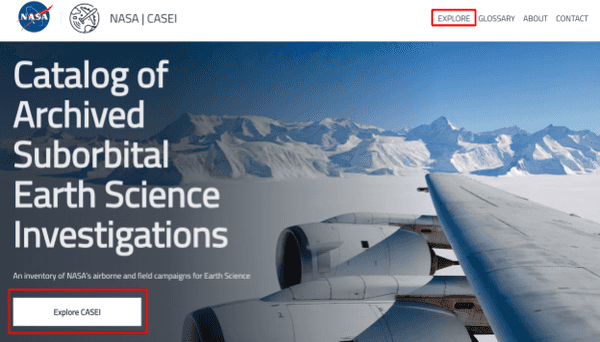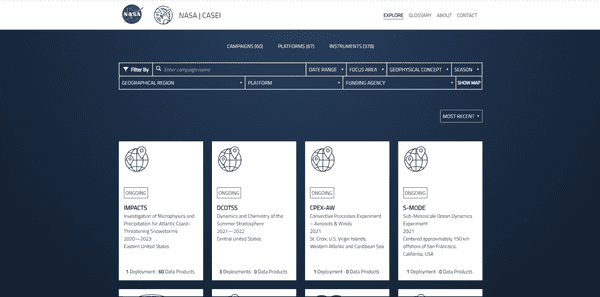FAQs
These are the most frequently asked questions. If you have any other questions, please contact us.
The Catalog of Archived Suborbital Earth Science Investigations (CASEI) is a curated inventory with information pertaining to NASA airborne and field campaigns, as well as information about the platforms and instruments used during the campaigns. CASEI also provides links to campaign data products via their digital object identifiers (DOIs). CASEI was designed to assist with data discoverability and accessibility. For more information, see the About page for CASEI.
CASEI is unique in that it is an information portal that collates metadata from across all NASA data centers and projects. It is often overwhelming to figure out the appropriate source to download data from or which information to trust. CASEI team members have already vetted and verified the information included in CASEI, removing the guesswork and reducing the struggle to search for airborne and field data.
Each campaign, platform, and instrument is intensively curated by three team members to ensure metadata quality and accuracy. This “human element” to the metadata curation makes it as thorough and accurate as possible.
No, CASEI does not archive or store data. CASEI provides data product Digital Object Identifiers (DOI) that link to the data archived at the NASA Distributed Active Archive Centers (DAACs). The NASA DAACs are the official data centers, meaning they distribute and preserve the data and support data users.
Using the data linked in CASEI, scientists can study a variety of phenomena such as hurricanes, lightning, atmospheric chemistry, air quality, precipitation, algal blooms, sea ice, surface water, and land cover, to name a few.
CASEI guides users to data collected during and associated with NASA airborne and field campaigns. These campaigns include different combinations of airborne data, field or ground-based data, ocean or water-based data, and also relevant or related satellite data and/or model outputs.
Geophysical concepts are terms that correlate to the six NASA Earth Science Focus Areas and the Global Change Master Directory (GCMD) Earth Science Keywords, bridging the gap between the general and specific terms used to describe scientific studies and data.

For CASEI, suborbital means anything that is not in orbit around the Earth. Therefore, suborbital includes measurements made in the air, on land, and on or within water.
Airborne data is that collected from instruments on board or attached to airplanes, drones, rockets, and balloons. Aircraft can be manned or unmanned. The term “balloons” refers to weather balloons, which usually carry instruments called “sondes” attached to the balloons by heavy duty string. Examples of these balloon payloads are ozonesondes or radiosondes, which measure ozone concentrations and vertical profiles of the atmosphere (like temperature, pressure, humidity), respectively.
Ocean or water data is that collected from instruments on board or attached to ships, boats, buoys, saildrones, or wave gliders. Sometimes ships are deployed on the ocean, but sometimes small boats are deployed on a lake, in a river, or in a swamp to collect water samples for use in analyzing water quality, for example.
Ground-based data is that collected from instruments on board or attached to vehicles, trailers, observation towers (such as weather or carbon flux towers), temporary field stations, or permanent instrument networks (such as Lightning Instrument Package (LIP) Network) . These are all known as ground-based platforms because they are located on land, and do not drop, fly, float, or sail.
There are multiple ways to search for data using CASEI. Using the Explore page, you can filter your search results with different fields.

You can get to the Explore page two ways: either by clicking the “Explore” at the top right of the screen from any page, or by clicking on the “Explore CASEI'' in the middle of the CASEI homepage. Both of these options will take you to CASEI’s Explore page.

Using the boxes at the top of the Explore page, you can filter your search results by a variety of fields. If you know the name of the campaign you are looking for, just type it into the search box on the top left. Other fields, such as focus area or geographical region have drop down boxes with lists to choose from. Multiple choices can be selected from these lists. Applied filters will be shown below the boxes. Campaigns that fit the criteria selected will be automatically listed. Clicking on the campaign boxes will take you to their respective homepages, where you can read more about each campaign. DOI links for the data products associated with the campaigns are located on the homepage.

You can also filter results by location using the map feature. Click on “show map” and a display with overlaid campaign bounding boxes will appear. When you select a bounding box, you will be automatically taken to the campaign associated with that box.

Yes. CASEI is built on top of a PostgreSQL database with multiple tables that each contain fields and foreign keys. Each endpoint in the API will point to its corresponding table. Access the CASEI API.
CASEI is a living inventory that the ADMG team continues to update. In order for a campaign to be included in CASEI, it must go through an intensive curation and review process by the ADMG team. If the campaign you need is not available in CASEI, it likely has not been completed yet. Once it is reviewed, it will become available in CASEI.
Currently, CASEI is still in a beta stage. Campaigns, platforms, and instruments are continually being added to CASEI. If you would like to request a campaign, instrument, or platform be added to CASEI, contact the ADMG team.
For a campaign to be included in CASEI, NASA must have led or participated in the campaign. If NASA provided the funding for the campaign, it is included. If NASA led the campaign, it is included. If NASA did not lead or fund the campaign, but two or more NASA instruments were used, or one NASA aircraft with at least one NASA instrument was used, the campaign is included in CASEI. If the campaign does not meet any of these criteria, the campaign is not included in CASEI.
If you have data for a campaign that meets the criteria, please contact the ADMG team.
To provide feedback about the design and/or the content of CASEI, please use the feedback button on the CASEI contact page.